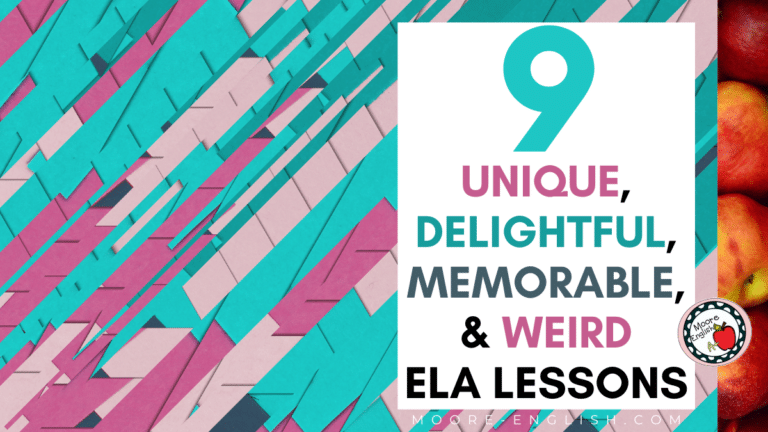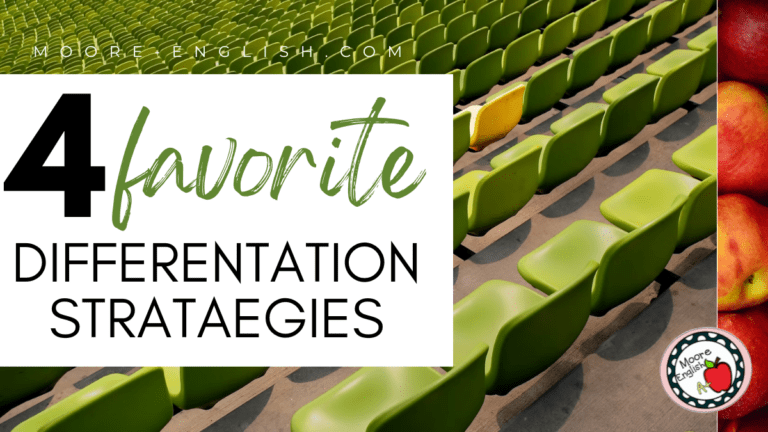Recently, I changed school districts. As part of the interview purpose, I was asked, “Is your classroom fun?”
After a pause, I replied, “My classroom can be fun, but that’s not my primary goal. My aim is to design an engaged classroom.”
While “fun” is a bonus, there’s no state standard focused on “fun.” In fact, I’m sure we’ve all been in classrooms that are “fun” but not meaningful. So instead of focusing on creating a fun classroom, I focus on designing an engaged classroom. Here are 4 strategies for engaging students.
This post this post may contain affiliate links. Please read the Terms of Use.
The Engaged Classroom Begins with You
The engaged classroom begins with you. The most effective tool you possess is your own enthusiasm, and that doesn’t cost you any extra time or money! When teachers are engaged in their content, they signal their dedication to students. Students want teachers who care about them and who care about their content. For me, letting my nerd flag fly helps create an engaged classroom.
As teachers, we may not love every task. No one loves standardized testing, fire drills, or supervision duty. However, any time you can consistently show engagement in your tasks (even when they are odious), you model for students the power of doing the same. In other words, whatever you do, do it well.
Choose Meaningful Texts
As English teachers, we are not always able to choose the texts we teach. Departments, teams, and curriculum offices may have an impact on that decision. However, when we do get to choose, it’s important to choose carefully.
Teachers do not have to let students choose every text. Rather, we simply have to choose meaningful, insightful texts. When you believe your content has value, you create an engaged classroom.
Here are some effective ways to choose meaningful texts:
- Consider some tortured poets a la Taylor Swift
- Provide abridged texts to focus student attention
- Try one of these 11 unexpected text pairings
- Seek out student book recommendations
- Feature diverse characters and stories
Emphasize Self-Efficacy
Building student self-efficacy is also key to creating an engaged classroom. An increased cognitive demand will help keep students engaged in classroom action. However, cognitive demand does not always have to be academic. Cognitive demand can also be procedural or metacognitive.
To increase self-efficacy, it’s important to focus on creating student-centered classroom procedures.
- Respond to student questions with a procedure rather than an answer. For example, “Do you have a pencil?” can be answered with “Where can you find extra pencils in this classroom?”
- Design sustainable, straight-forward procedures that are easy for you and for students to remember. Practice being consistent with turn-in, restroom, hand-raising, library etc.
- Emphasize absent-work, late-work, and assessment-revision policies that make students responsible for their paper management.
Incorporate Movement
Perhaps the most common way to design an engaged classroom is to invite meaningful movement. In other words, an engaged body and an engaged mind create an engaged classroom.
Some of my favorite ways to incorporate classroom movement involve stations, task cards, or gallery walks. But it’s important to remember that classroom movement can also be more subtle like think-pair-share or turn-and-talk. Not all meaningful movement has to be enormous. Small movements can be just as powerful in creating an engaged classroom.
Favorite Resources for an Engaged Classroom
When I’m looking for strategies to create an engaged classroom, these are my go-to tools. These are resources that help involve students and make them active participants at every turn.
- Texts about basketball, hunting, and protests
- 4 Steps to Pre-Read Nonfiction and Poetry
- Grammar and Vocabulary Games
- ELA Task Cards












